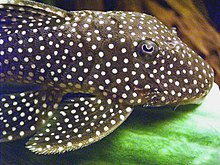L number
The L numbers are a code system from the aquarium hobby . It was introduced to name newly imported, not exactly identifiable Loricariids ( armor catfish ).
The L-number code system


The “L” stands for Loricariidae , a fish family from the order of the catfish that occurs in Central and South America . The L number is assigned consecutively. There must be a space between "L" and number.
The prerequisite for receiving an L number is the presentation of the species in DATZ ("The Aquarium and Terrarium Magazine"). L-numbers are only given to ancistrine and hypostomine loricariids . Initially, new loricariine introductions were given a number (L 10, L 53, L 62). In some cases, numbers have also been withdrawn and reassigned, which regularly causes confusion (e).
The system was invented by Rainer Stawikowski (editor-in-chief of DATZ), Arthur Werner (owner of the transfish company) and Uli Schliewen in the summer of 1988, after a large number of undescribed armored catfish had been newly imported. In the meantime, many L-catfish have been scientifically described (e.g. L 1 is now called Glyptoperichthys joselimaianus ). With the scientific description of a species, the code number is theoretically obsolete. In practice, it continues to be used, at least for frequently traded species. An example of this is the Hypancistrus zebra , described since 1991 , which is still known as L 46 .
In April 2015 there were 475 L numbers, which, however, do not stand for the corresponding number of species, but also for locality variants, one-off mutations (L 98) and the like.
Alternative code systems
A similar system was introduced by the magazine Das Aquarium and adopted by AqualogNews after the magazine was discontinued: the LDA numbers (as of May 1, 2007: 104 LDA numbers). Due to editorial times and competition from publishers , authors , etc., it often happens that types or variants are given an L and LDA number.
Code systems have also been developed for other fish groups (for example “CH” for haplochromine cichlids from Lake Victoria ), which, however, could not prevail due to a lack of new imports. However , the system also works with C numbers for armored catfish species ( C allichthyidae) (as of June 2009: 159 C numbers).
ID
There are several works for identification: On the one hand the respective articles of DATZ (or Das Aquarium ), on the other hand the Aqualog and the DATZ special issue "L-Numbers - The Original".
In the current edition of the Aqualog ("All L-Numbers") there are hardly any misidentifications in contrast to the 1st edition. In contrast to the first edition, only two seldom introduced species are shown as drawings in the current edition because the authors did not have any living copies available. Care instructions are to be viewed with caution. It is the only book that also contains all LDA numbers.
The DATZ special issue contains the original photos of the performance. Whether it is therefore more suitable for identification in any case cannot be answered in principle in the affirmative, because instead of an image the Aqualog almost always contains several perspectives of an animal and in many cases images of different animals, whereby the variation of a species is also taken into account. However, the LDA numbers are not shown in the DATZ special issue.
literature
- DATZ Special (2004): L-Numbers, L-Numbers . Publishing house Eugen Ulmer.
- Schraml, E. & F. Schäfer (2004): Aqualog Loricariidae: all L-Welse, all L-numbers . 272pp + 1,800 photos. Publishing house ACS
- Werner, A., W. Lechner & J. Schmidt (2005): Mini-Atlas L-Welse. L1 to L400 . bede publishing house.
Web links
- www.planetcatfish.com: L-Numbers (English)
- www.welse.net: L numbers
- www.l-welse.com: L numbers
- www.suedamerikafans.de: L numbers
- www.suedamerikafans.de: LDA numbers